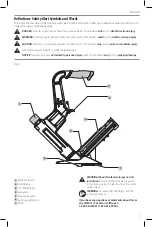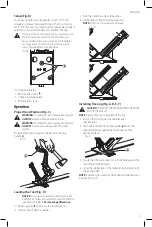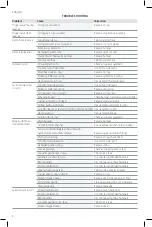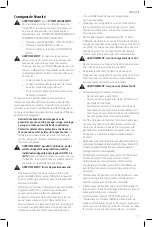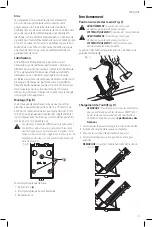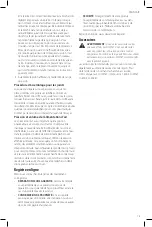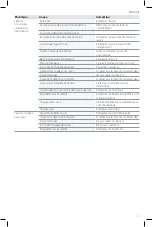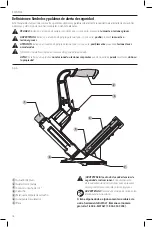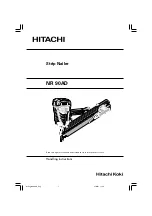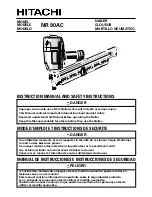
3
English
Safety Information
WARNING: ALWAYS
use safety glasses. Everyday
eyeglasses are NOT safety glasses. Also use face or
dust mask if cutting operation is dusty. ALWAYS WEAR
CERTIFIED SAFETY EQUIPMENT:
• ANSI Z87.1 eye protection (CAN/CSA Z94.3),
• ANSI S12.6 (S3.19) hearing protection,
• NIOSH/OSHA/MSHA respiratory protection.
WARNING:
Some dust created by power sanding,
sawing, grinding, drilling, and other construction
activities contains chemicals known to the State
of California to cause cancer, birth defects or
other reproductive harm. Some examples of these
chemicals are:
• lead from lead-based paints,
• crystalline silica from bricks and cement and other
masonry products, and
• arsenic and chromium from chemically-
treated lumber.
Your risk from these exposures varies, depending on how
often you do this type of work. To reduce your exposure to
these chemicals: work in a well ventilated area, and work with
approved safety equipment, such as those dust masks that are
specially designed to filter out microscopic particles.
•
Avoid prolonged contact with dust from power
sanding, sawing, grinding, drilling, and other
construction activities. Wear protective clothing and
wash exposed areas with soap and water.
Allowing
dust to get into your mouth, eyes, or lay on the skin may
promote absorption of harmful chemicals.
WARNING: Always wear proper personal hearing
protection that conforms to ANSI S12.6 (S3.19)
during use.
Under some conditions and duration
of use, noise from this product may contribute to
hearing loss.
WARNING:
(Air and Supply)
• Do not use oxygen, combustible gases, or bottled
gases as a power source for this tool as tool may
explode, possibly causing injury.
• Do not use supply sources which can potentially
exceed 200 P.S.I.G. (14kg/cm2) as tool may burst,
possibly causing injury.
• The connector on the tool must not hold pressure
when air supply is disconnected. If a wrong fitting
is used, the tool can remain charged with air
after disconnecting and thus will be able to drive
a fastener even after the air line is disconnected
possibly causing injury.
• Do not pull trigger or depress contact arm while
connected to the air supply as the tool may cycle,
possibly causing injury.
• Always disconnect air supply: 1.) Before making
adjustments; 2.) When servicing the tool; 3.) When
clearing a jam; 4.) When tool is not in use; 5.) When
moving to a different work area, as accidental
actuation may occur, possibly causing injury.
WARNING:
When operating the tool:
• Always handle the tool with care:
-
Never engage in horseplay;
-
Never pull the trigger unless nose is directed
toward the work;
-
Keep others a safe distance from the tool
while tool is in operation as accidental
actuation may occur, possibly causing injury.
• The operator must not hold the trigger pulled
on contact arm tools except during fastening
operation as serious injury could result if the trip
accidentally contacted someone or something,
causing the tool to cycle.
• Keep hands and body away from the discharge
area of the tool. A contact arm tool may bounce
from the recoil of driving a fastener and an
unwanted second fastener may be driven possibly
causing injury.
• Check operation of the contact arm mechanism
frequently. Do not use the tool if the arm is not
working correctly as accidental driving of a
fastener may result. Do not interfere with the
proper operation of the contact arm mechanism.
• Do not drive fasteners on top of other fasteners
or with the tool at an overly steep angle as this
may cause deflection of fasteners which could
cause injury.
• Do not drive fasteners close to the edge of the
work piece as the wood may split, allowing the
fastener to be deflected possibly causing injury.
• This nailer produces SPARKS during operation. NEVER
use the nailer near flammable substances, gases or
vapors including lacquer, paint, benzine, thinner,
gasoline, adhesives, mastics, glues or any other
material that is -- or the vapors, fumes or byproducts
of which are -- flammable, combustible or explosive.
Using the nailer in any such environment could cause
an EXPLOSION resulting in personal injury or death to
user and bystanders.
WARNING:
When maintaining the tool:
• When working on air tools note the warnings in
this manual and use extra care when evaluating
problem tools.
WARNING:
When loading tool:
• Never place a hand or any part of body in fastener
discharge area of tool;
• Never point tool at anyone;
• Do not pull the trigger or depress the trip as
accidental actuation may occur, possibly
causing injury.



